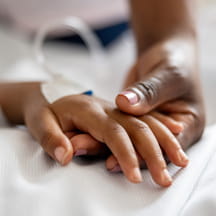Edward lives in a small village on the Yukon River in southwest Alaska without running water or reliable electricity and is 400 miles off the road system. At two months old, he developed seizures and was flown in an air ambulance to the Alaska Native Medical Center in Anchorage, Alaska, where he was diagnosed with meningitis.
I met Edward when I was a first-year resident at Seattle Children’s. He was 8 years old and being evaluated for severe lung scarring, a condition called bronchiectasis, due to years of recurrent pneumonia from weakened muscles caused by his meningitis.
I took care of Edward again in Bethel, Alaska, where he was admitted for another case of pneumonia. Edward was frequently admitted to the hospital because the limited electricity in his village prevented effective nebulizer breathing treatments, and the lack of running water caused higher rates of infection.
I was in the second year of my residency training and in a special program, the Alaska Track, where select residents train at academic centers in Seattle as well as community clinics and hospitals in Alaska. In my third and final year of residency, I saw Edward again at Seattle Children’s, where he had part of his scarred left lung removed.
Now, I work both as a pediatrician and educator of pediatric residents at the Alaska Native Medical Center where Edward was first treated. As a pediatric hospitalist, workforce shortages affect my ability to effectively care for children every day, be it the lack of physicians with limited pediatric expertise in remote Alaskan communities or limited numbers of pediatric-trained nurses, respiratory therapists, pharmacists, and dieticians at the hospital.
These shortages not only affect clinical care but also limit the work we can do to address health disparities within our communities, which is a large part of my work and passion and what led me to pursue pediatric health care in Anchorage. Inspiring and equipping more residents to provide pediatric care is one significant way to make progress toward these goals.
I teach pediatric residents as an associate program director for the Seattle Children’s Alaska Track Primary Care Program, the same program I trained in. Beginning in 2012, our program has graduated 32 pediatricians, of which 18 have returned to work in Alaska and five in rural communities throughout the country. Our graduates become inspired to work in communities where access to pediatricians is limited and are filling the needs of these communities.
This selective program is possible because of a federally funded residency program called the Children’s Hospitals Graduate Medical Education (CHGME) program. CHGME is the only federal program solely devoted to the training of pediatricians and pediatric subspecialists. It supports the training of more than half of all pediatricians and pediatric specialists.
Even though only a small number of children’s hospitals provide training funded by CHGME, those graduates care for children throughout the entire country, even in the farthest regions of the most distant state, Alaska.
CHGME needs increased funding to sustain and expand the pediatric physician workforce, so children like Edward can continue to benefit from increased access to pediatricians in remote communities. The more children’s hospitals include their voices, the greater chance of reaching the ears of our representatives.
Edward is now 16 years old. He rarely comes to the hospital, and his primary care doctor is one of our Alaska Track program graduates.


